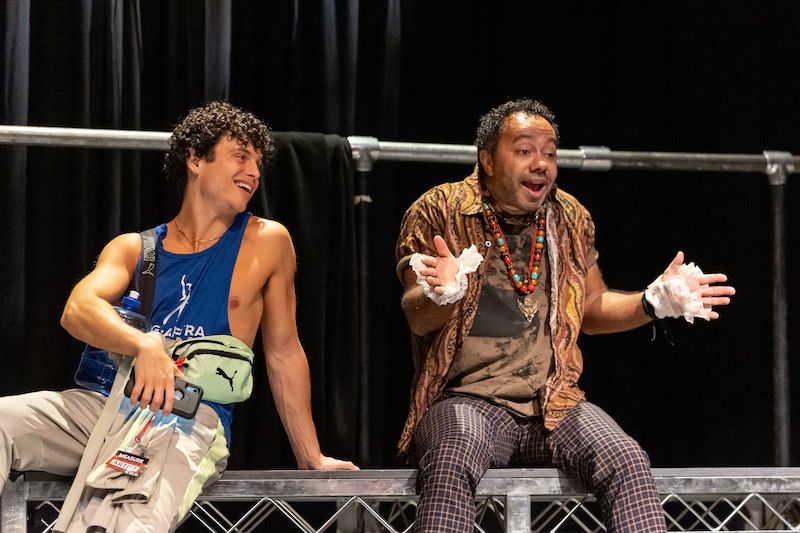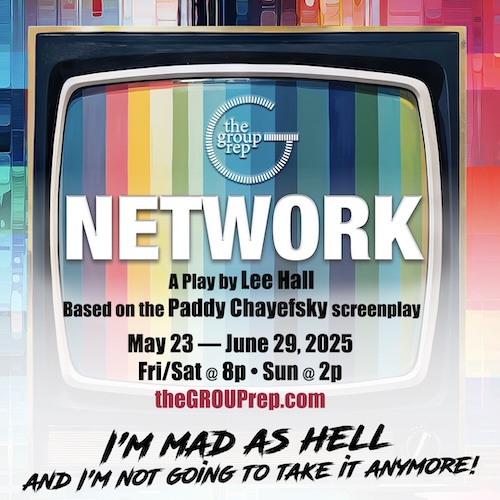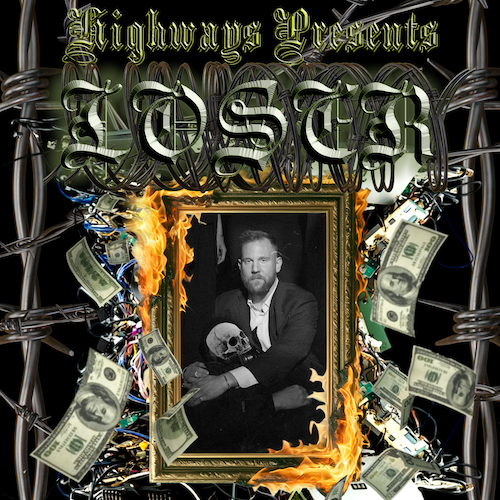
Alexander Matos and Randolph Thompson (Photo by Brian Hashimoto)
Reviewed by Steven Leigh Morris
Boston Court Performing Arts Center
Through Oct. 15.
RECOMMENDED
There’s a conundrum with immersive theater that manifests when the audience is guided, in groups, to bear witness to animated slices of life, as though in a museum exhibit.
Playwright-director Jessica Kubzansky tries that through the first half of her Measure Still for Measure, a riff on Shakespeare’s twisted immorality play, Measure for Measure.
When the audience isn’t meeting actors arriving in the parking lot (all part of the conceit), they’re watching them warm up in the lobby, observing them running either their lines, or lines from some melodramatic flick they’re auditioning for; or pleading with a bank to waive a late charge because their paycheck will be coming soon; or in the middle of an intense interaction, taking a phone call from their mother; or revealing that somebody’s relative has multiple sclerosis; or doing chin-ups under a stairwell; or discussing the difference between SAG health insurance and AFTRA health insurance, and health insurance in general.
Most of this has nothing to do with the actual ideas embodied in Measure for Measure. This might all be rationalized as getting to know the actors in a play (Shakespeare’s) within-the-play and their back stories, but still. If this is intended to be part of some funnel action, the larger end of the funnel is very, very, wide, so wide that when the chemicals inside it get tossed around, Measure for Measure almost falls out of it. Almost.
This raises the question: Why does this long, immersive prelude feel so artificial?
In other immersive productions, my reviewer colleagues have expressed a reluctance to voice their annoyance at such devices, for fear of belittling something so innovative.
Let such timidity end here. Immersive theater is no longer innovative. It’s entirely possible, let’s admit, that it can be as annoying and unpersuasive as any other theatrical contrivance. Yet the use of the immersive conceit creates a problem for Kubzansky’s production mainly when her play settles into its real reason-to-be, in the second half.
In that second half, the actors are rehearsing Measure for Measure on the theater stage, in the theater-proper, upon a set that’s half built (marvelously designed by Francois-Pierre Couture).
At the start of part deux, the director (Rob Beitzel), here named Bruce Elliot Norton, explains the entire plot of Measure for Measure to actors who would already be fully cognizant of it, and its ramifications, by this point in the rehearsal process. Director Bruce’s nominal synopsis of the play is the kind of expository device generally accepted and used to great effect in opening scenes from Oedipus the King to Hamilton. In Measure Still for Measure, however, the artifice of a stage director explaining the rudimentary story of a play to actors who have been rehearsing
it for weeks clashes with the hyper-realistic, slice-of-life style of the production’s immersive prelude — like two plays with slightly different rules of engagement.
So why is the plot summary even needed? These are not the kind of actors who look like they’ve been sleepwalking through table-reads of the play. It’s actually for the benefit of audiences who may have wandered into the Boston Court Performing Arts Complex with little or forgotten knowledge of Measure for Measure. Because, you need to know Measure for Measure pretty well in order to get the best mileage from this production.
This reliance on prior knowledge of the play renders the entire show something of a rarefied spectacle: theater for theater people, perhaps more self-edifying than inviting to the uninitiated.
And yet, truth be told, the second half is pretty marvelous, largely because that’s when the story of a production in rehearsal really starts to ring true, and the actors are all so good in conveying that truth.
Measure for Measure is a story of Vienna in moral decay; of its Duke Vincentio (Beitzel), who chooses to take leave of the place, or pretends to; and the comedy rollicks through the hypocrisy of Vincentio’s ever-so-puritan deputy, Angelo (Leo Marks), in enforcing standards of sexual decency that he, Angelo, has no intention of following himself. A crisis of nerve comes when a young man, Claudio (Alexander Matos), receives a death sentence from the newly appointed morality policeman, Angelo. Claudio’s crime?: intimate relations with a woman whom he intends to wed. Claudio’s nun-in-training sister Isabella (Bukola Ogunmola) pleads with Angelo for her brother’s life. In that pleading, something happens to Angelo: lust or love, or both. His abuse of power is so transparent, Angelo morphs into an antecedent of Tartuffe. That Shakespeare named such a cad after an angel has to be one of his many jokes.
When this ensemble conveys the rehearsal process, the spectacle contains rich veins of, well, theater: questions of motive, motivation, interpretation, misinterpretation, perception and misperception — a crystalized microcosm of how we all move through life. When Bruce works with the actor named Sam (Marks), who is portraying Angelo, and Dionna (Ogunmola), who is playing Isabella, they re-work the scene and we witness the permutations of an encounter emerging from the ether — teasing out threads of love and lust and abuse — all with striking
authenticity. This is where both Bruce and Kubzansky prove to be such effective directors.
Bruce’s actions will come to mirror Angelo’s with an egregious abuse of one actor. This is the heart of the matter, illustrating how Shakespeare’s play is a flame that keeps flaring.
Nothing would be lost, and a great deal would be gained, from jettisoning the immersive first half. Then get a grant, which would be well-deserved, to tour that 60-minute second half in high schools to students who are studying Measure for Measure as part of their curriculum. (That takes care of the problem of people needing to know the play before seeing this show.) What an enriching service that would be. What a privilege for those students, to see a play so beautifully performed, an object lesson in how a production is built, unfolding before their eyes, the rehearsal of a play from the start of the 17th century that nonetheless addresses the issues of sexual abuse and bullying that they’re already either experiencing or reading about on social media. I’d help write the grant.
Boston Court Performing Arts Center, 70 Mentor Ave., Pasadena: Mon., Thurs., and Sat., 8 pm; Sun., 2 pm; check weekly schedule for specific performance days and times; thru Oct.
15. https://BostonCourtPasadena.org Running time: Two hours with intermission











